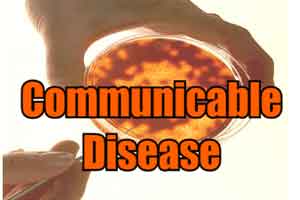- Home
- Editorial
- News
- Practice Guidelines
- Anesthesiology Guidelines
- Cancer Guidelines
- Cardiac Sciences Guidelines
- Critical Care Guidelines
- Dentistry Guidelines
- Dermatology Guidelines
- Diabetes and Endo Guidelines
- Diagnostics Guidelines
- ENT Guidelines
- Featured Practice Guidelines
- Gastroenterology Guidelines
- Geriatrics Guidelines
- Medicine Guidelines
- Nephrology Guidelines
- Neurosciences Guidelines
- Obs and Gynae Guidelines
- Ophthalmology Guidelines
- Orthopaedics Guidelines
- Paediatrics Guidelines
- Psychiatry Guidelines
- Pulmonology Guidelines
- Radiology Guidelines
- Surgery Guidelines
- Urology Guidelines
Communicable diseases rise 32 perccent in 5 years, spending up 7 percent

Spending on programmes to control India's three main communicable diseases malaria, tuberculosis and leprosy increased seven percent over five years while cases reported, taken together, increased 32 percent, according to an India Spend analysis of government data.
There has been a steady increase in the incidence of communicable diseases over the last five years, except malaria which declined 14 percent, which can be attributed to a special focus on awareness and detection.
We found a correlation between cases reported and budgets over five years. As funding rose, cases declined.
The central government finances three disease-control programmes: National Vector Borne Disease Control Programme (NVBDCP); Revised National Tuberculosis Control Programme (RNTCP); and National Leprosy Eradication Programme (NLEP).
The programmes are funded under the National Health Mission, which also includes programmes for child - and maternal health, health infrastructure, prevention, early detection, diagnosis and treatment.
There was a 12 percent increase in the National Health Mission budget, from Rs.17,188 crore to Rs.19,307 crore between 2012 and 2016, according to an Accountability Initiative report in February 2016.
In dollar terms, the allocation declined from $3.2 billion to $2.9 billion. There has been an increase in the exchange rate from Rs.51 per dollar in 2011-12 to Rs.65 per dollar in 2016-17. The value of Indian money to the dollar has depreciated over the last five years.
Communicable disease profile in India
The allocated funding has been increasing for the three main programmes, as we said, and is up 7.2 percent over five years, from Rs.924 crore in 2011-12 to Rs.991.5 crore in 2015-16.
The National Vector Borne Disease Control Programme covers malaria, dengue, chikunguniya and Japanese encephalitis, and also works for the elimination of kala-azar and lymphatic filariasis. The allocation to the programme has seen a three percent decline, from Rs.482 crore in 2011-12 to Rs.463 crore in 2015-16.
While malaria cases declined 14 percent, dengue cases increased more than four times and chikunguniya and Japanese encephalitis rose 33 percent, according to a reply in the Lok Sabha.
The tuberculosis-control budget rose 23 percent between 2011 and 2016, while cases reported almost doubled over the same period.
While there was a 16 percent decline in funding for the leprosy eradication programme, there was a 36 percent increase in leprosy cases nationwide.
There are also a host of other reasons, including dearth of awareness and access to medicine and treatment, which may have contributed to the rise of communicable diseases.
Over the last five years, funds released from the centre to the states under the three main programmes has been declining - from Rs.947 crore in 2011-12 to Rs.395 crore in 2015-16.
In the years 2011-12 and 2014-15, more funds were released than were allocated for the programmes.
In 2012-13, states received only half the funds budgeted for vector-borne diseases and leprosy.

Disclaimer: This site is primarily intended for healthcare professionals. Any content/information on this website does not replace the advice of medical and/or health professionals and should not be construed as medical/diagnostic advice/endorsement or prescription. Use of this site is subject to our terms of use, privacy policy, advertisement policy. © 2020 Minerva Medical Treatment Pvt Ltd